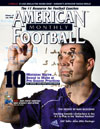AMERICAN FOOTBALL MONTHLY THE #1 RESOURCE FOR FOOTBALL COACHES
Article CategoriesAFM Magazine
|
The 5th Down: Playing Time© More from this issueTim Dodson, Head Coach, Siuslaw High School, Florence, OR “First I think it is important to describe our school because size of school and coaching staff have a great deal on how playing time is handled. We are a 450 student high school and we have around 30 players on our varsity roster and 35 players in our frosh/soph program. We have three coaches with our frosh/soph team and three coaches with our varsity team. Our frosh/soph coaches are busy on our game night and we aren't able to use them for personnel grouping. So we have a volunteer coach who organizes our substitution patterns for games. Before each game we sit down and use a matrix for each offensive and defensive position in the half. We place our starters on offense and defense first. Then we begin the process of placing our substitutes for each poss....The full article can only be seen by subscribers. Subscribe today!
|
|
|||||||
| HOME |
MAGAZINE |
SUBSCRIBE | ONLINE COLUMNISTS | COACHING VIDEOS |
Copyright 2025, AmericanFootballMonthly.com
All Rights Reserved





